

Category:DIN 4844-2 warning signs (vector drawings) European hazard symbols. The Hazard symbols for chemicals are pictograms defined by the European community for labeling chemical packagings (for storage and workplace) and containers (for transportation).
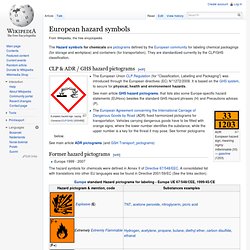
They are standardized currently by the CLP/GHS classification. CLP & ADR / GHS hazard pictograms[edit] European hazard sign, saying Corrosive (CLP/GHS) [GSH05]) The European Union CLP Regulation (for "Classification, Labelling and Packaging") was introduced through the European directives (EC) N°1272/2008. It is based on the GHS system, to secure for physical, health and environement hazards. NFPA 704. "NFPA 704: Standard System for the Identification of the Hazards of Materials for Emergency Response" is a standard maintained by the U.S.
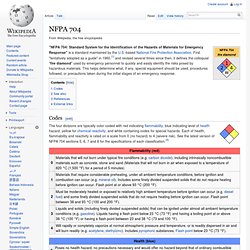
-based National Fire Protection Association. First "tentatively adopted as a guide" in 1960,[1] and revised several times since then, it defines the colloquial "fire diamond" used by emergency personnel to quickly and easily identify the risks posed by hazardous materials. This helps determine what, if any, special equipment should be used, procedures followed, or precautions taken during the initial stages of an emergency response. Codes[edit] See also[edit] Search results for "hazmat symbol" En:U.S.

Category:R14-2 - Hazardous Materials Permitted. Category:SVG safety symbols. Category:DIN 4844-2 safety signs (vector drawings) Radioactive.svg. Cancel Edit Delete Preview revert Text of the note (may include Wiki markup) Could not save your note (edit conflict or other problem).
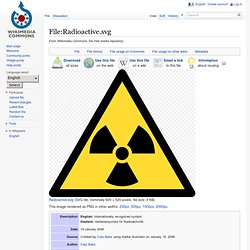
Please copy the text in the edit box below and insert it manually by editing this page. Upon submitting the note will be published multi-licensed under the terms of the CC-BY-SA-3.0 license and of the GFDL, versions 1.2, 1.3, or any later version. See our terms of use for more details. Add a note Draw a rectangle onto the image above (press the left mouse button, then drag and release).
Save To modify annotations, your browser needs to have the XMLHttpRequest object. [[MediaWiki talk:Gadget-ImageAnnotator.js|Adding image note]]$1 [[MediaWiki talk:Gadget-ImageAnnotator.js|Changing image note]]$1 [[MediaWiki talk:Gadget-ImageAnnotator.js|Removing image note]]$1. Gefahrensymbol. Ein Gefahrensymbol ist ein nur noch übergangsweise geltendes Piktogramm auf orangem Untergrund, das zusammen mit einer bestimmten Gefahrenbezeichnung einen ersten, leicht erkennbaren Hinweis auf die Gefahren gibt, die von einem Gefahrstoff ausgehen (siehe auch: Gefahrstoffkennzeichnung).
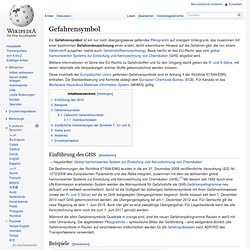
Basis hierfür ist das EU-Recht, was vom global harmonisierten Systems zur Einstufung und Kennzeichnung von Chemikalien (GHS) abgelöst wird. Weitere Informationen im Sinne des EU-Rechts zu Gefahrstoffen und für den Umgang damit geben die R- und S-Sätze, mit denen ebenfalls alle Verpackungen solcher Stoffe gekennzeichnet werden müssen.
Diese innerhalb der Europäischen Union geltenden Gefahrensymbole sind im Anhang II der Richtlinie 67/548/EWG enthalten. Workplace Hazardous Materials Information System. Das Workplace Hazardous Materials Information System (WHMIS; franz.
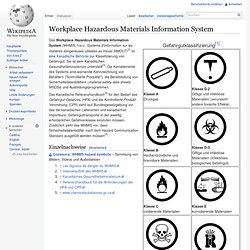
Système d'information sur les matières dangereuses utilisées au travail SIMDUT)[2] ist eine Kanadische Behörde zur Klassifizierung von Gefahrgut. Sie ist dem Kanadischen Gesundheitsministerium unterstellt[3]. Die Kernelemente des Systems sind warnende Kennzeichnung von Behältern ("kontrollierte Produkte"), die Bereitstellung von Sicherheitsdatenblättern (material safety data sheets MSDSs) und Ausbildungsprogrammen. Das Kanadische Referenzhandbuch[4] für den Bedarf des Gefahrgut-Gesetzes (HPA) und die Kontrollierte Produkt-Verordnung (CPR) sieht laut Bundesgesetzgebung vor, das die kanadischen Lieferanten und kanadischen Importeure, Gefahrguttransporte in der jeweilig erforderlichen Gefahrenklasse einstufen müssen.
Zusätzlich sieht das WHMIS vor, dass Sicherheitsdatenblätter nach dem Hazard Communication Standard ausgefüllt werden müssen[5]. Warning sign. Exhibit mostly of various warning signs, Turin automotive museum (some regulatory signs like Do Not Enter also visible).
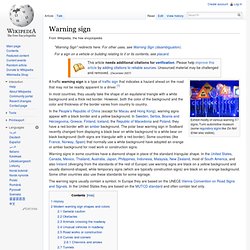
A traffic warning sign is a type of traffic sign that indicates a hazard ahead on the road that may not be readily apparent to a driver.[1] In most countries, they usually take the shape of an equilateral triangle with a white background and a thick red border. However, both the color of the background and the color and thickness of the border varies from country to country. Warning signs in some countries have a diamond shape in place of the standard triangular shape. In the United States, Canada, Mexico, Thailand, Australia, Japan, Philippines, Indonesia, Malaysia, New Zealand, most of South America, and also Ireland (diverging from the standards of the rest of Europe) use warning signs are black on a yellow background and usually diamond-shaped, while temporary signs (which are typically construction signs) are black on an orange background.
History[edit] U.S.